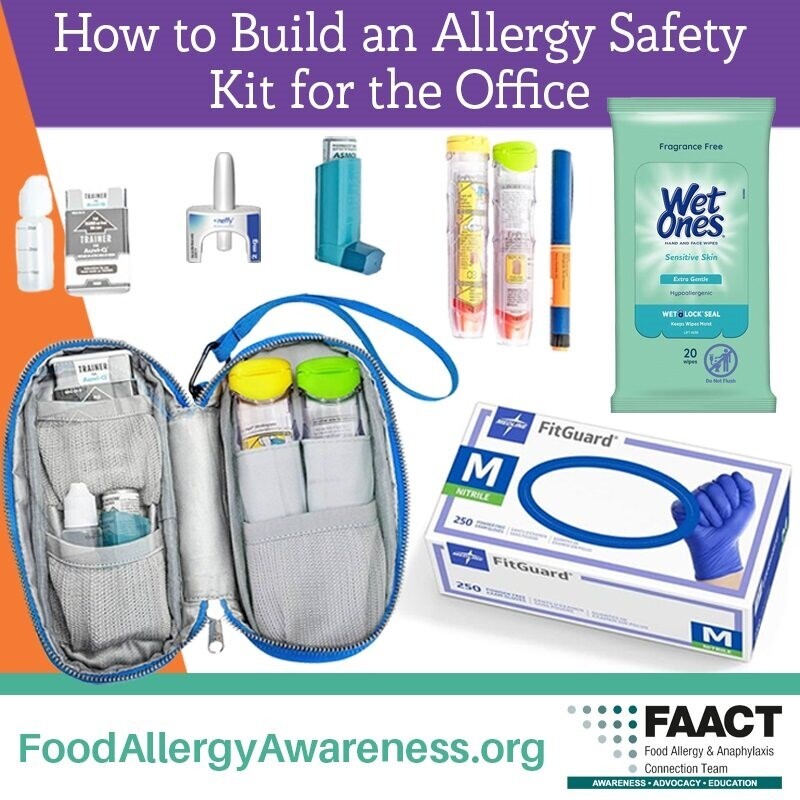How to Build an Allergy Safety Kit for the Office

Allergic reactions can occur suddenly and without warning and having the right tools at your disposal can make the difference between a minor incident and a serious health emergency.
Creating an allergy safety kit for your office is not just a precaution; it’s a responsibility that can safeguard your employees’ health and provide peace of mind.
In this blog, we will guide you through the process of building an effective allergy safety kit for your office. We’ll cover the essential items to include, tips on how to store and organize the kit, and best practices for maintaining and updating it over time. By the end, you’ll have a comprehensive plan to ensure that your workplace is well-prepared to handle allergic emergencies, helping to foster a safer, more inclusive environment for everyone.
Essential Items for Your Office Food Allergy Safety Kit
Creating a comprehensive food allergy safety kit for your office is crucial to ensure a quick and effective response to allergic reactions involving food.
Here’s a list of six essential items that should be included in every office food allergy safety kit:
1. Signs & Symptoms of Anaphylaxis Poster:
Symptoms of anaphylaxis can develop rapidly after exposure to an allergen, usually reaching peak severity within 5 to 30 minutes, but this may be delayed up to 2 hours. Sometimes, a second phase reaction (Biphasic Anaphylaxis) can occur 6-36 hours after the initial anaphylactic reaction in as many as 20% of individuals. Biphasic reactions have been reported to occur even as far out as 72 hours after the initial reaction, though this is rare.
2. Epinephrine Devices:
These life-saving devices are used to treat severe allergic reactions, known as anaphylaxis, that can result from food allergens. Make sure to have multiple devices on hand, as some individuals may require more than one dose.
3. Antihistamines:
Over-the-counter antihistamines, such as Cetirizine (Zyrtec)
can help alleviate mild to moderate allergic symptoms caused by food, including hives, itching, and swelling.
4. Non-Latex Gloves:
Include non-latex gloves in your kit for safe handling of food or administering first aid, ensuring that individuals with latex allergies are also protected.
5. Allergy & Anaphylaxis Emergency Plan:
Include a clear and concise action plan outlining the steps to take in case of a food allergy reaction. This should be easily accessible and understood by all employees.
6. Allergen-Free Wipes:
Keep allergen-free wipes in your kit to clean surfaces and utensils, helping to prevent cross-contact and accidental exposure to food allergens.
7. Medical Contact Information:
Keep a list of emergency contacts, including local emergency services and nearby medical facilities, readily available.
By ensuring your kit is well-stocked with these essentials, you can be prepared to respond swiftly and effectively to any food allergy emergencies that may arise in the workplace.
How to Store and Organize Your Food Allergy Safety Kit
Proper storage and organization of your food allergy safety kit are crucial to ensure its accessible and easy to use during an emergency. Life-saving medications, such as epinephrine, should NEVER be locked up.
Consider the following tips:
- Central Location: Place the kit in a central, easily accessible location known to all employees, such as a break room, first aid station, or reception area.
- Clear Labeling: Label the kit with bold, easy-to-read text. Use color-coded labels or signage to distinguish it from other first aid supplies, making it immediately recognizable.
- Prioritize Organization: Organize the contents to prioritize quick access. Place essential items like epinephrine devices and antihistamines at the top. Use dividers or compartments to keep items separated and prevent clutter.
- Accessibility: Ensure the kit is secure to prevent tampering but remains easily accessible. A transparent case or see-through lid can help identify contents.
- Regular Maintenance: Schedule regular checks to ensure all items are in place, unexpired, and in good working condition. Assign a person or team to maintain the kit and restock as needed.
How to Maintain and Update Your Food Allergy Safety Kit
Maintaining and updating your food allergy safety kit is essential to ensure it’s always ready for use.
Here’s how to keep it in top condition:
- Regular Inspections: Schedule monthly checks to verify that all items are present, in good condition, and within their expiration dates. Replace expired or damaged items immediately, especially critical supplies like epinephrine devices and antihistamines.
- Inspection Log: Keep a log of each inspection, noting the date and any replacements or additions made. Ensure this log is easily accessible to all employees.
- Stay Updated: Stay informed about new food allergy management products or updated guidelines and incorporate these into your kit as necessary.
- Staff Training: Hold periodic training sessions to refresh staff on the contents and proper use of the kit.
By following these steps, you can ensure your food allergy safety kit remains effective, reliable, and ready to protect the health of everyone in the workplace.
Ensure Your Office Safety with FAACT
Creating and maintaining an allergy safety kit in your office is more than just a precaution—it's a commitment to the well-being of everyone in your workplace.
By following FAACT on food allergy preparedness, you can ensure that your office is equipped to handle any allergic emergencies swiftly and effectively. From understanding the essential items to store in your kit, to organizing, maintaining, and updating it regularly, each step plays a crucial role in safeguarding your employees' health.
Preparedness doesn't just protect those with known allergies; it creates a safer environment for everyone. With the right tools and knowledge in place, you can minimize risks and respond confidently in the event of an allergic reaction.
Prioritizing food allergy safety is a powerful way to demonstrate care and responsibility in your workplace, ensuring that your office is a secure and inclusive space for all.
Curious about food allergy awareness? Connect with us on Facebook, Instagram, X, LinkedIn, Pinterest, TikTok, and YouTube!

